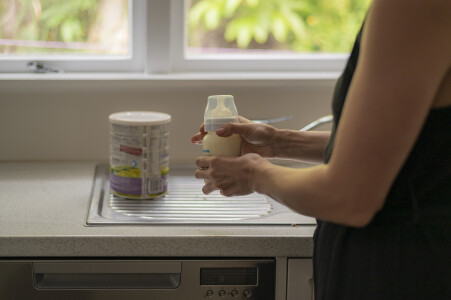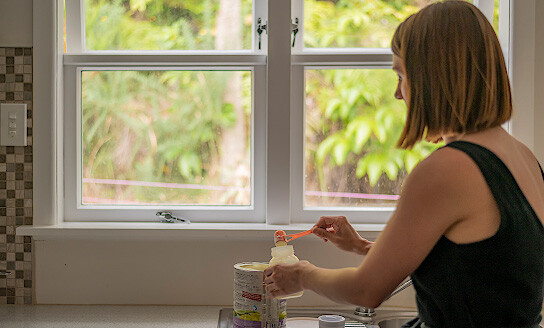Thinking about feeding your baby
When you’re pregnant, it’s good to think about how you want to feed your baby once they're born.
For some mums there are many things to consider, like your cultural beliefs, personal circumstances, and your own physical and mental wellbeing. Talk to your partner, family/whānau, and your midwife or maternity carer about it, and have a plan so they know how they can help you.
If you want to breastfeed and you’re having trouble, you can call PlunketLine for free any time on 0800 933 922.
About baby formula
Most baby formula is made from cow’s milk modified to make it suitable for babies. But it’s not the same as cow’s milk.
Why babies need formula rather than cow’s milk
Here’s why you shouldn’t give cow’s milk to your baby as a main drink until they’re over 12 months old:
- all baby formula has added minerals, vitamins, and fats that babies need and can’t get from straight cow’s milk
- babies can’t digest cow’s milk as easily or completely as breastmilk or formula
- the protein level in cow’s milk is too high for babies - in formula some of this protein has been taken out.
Babies under 12 months old shouldn’t have:
- regular cow’s milk
- skim, powdered, evaporated, or sweetened condensed milk
- dairy alternatives like soy, rice, almond or coconut milk.
Which baby formula is best?
The formula aisle at the supermarket can be quite overwhelming, and it can be hard to know which will work best for your baby.
In New Zealand, the manufacturing of infant formula is governed by Food Standards Australia and New Zealand (FSANZ). There are strict regulations, and all formula for sale in New Zealand will be good quality, with all the nutrients your baby needs.
Here’s some information about the kinds of formula you can buy.
Cow’s milk-based formula
All cow’s milk-based infant formula brands sold here have a similar nutritional profile and are suitable for most babies. The fact one brand is more expensive, or your hospital uses it, doesn’t necessarily make it better than any other.
Casein and whey are the proteins in breast milk, and cow’s milk formula has the same proteins. Cow’s milk formula is usually labelled as either casein-dominant or whey-dominant, meaning the formula either has more casein or more whey. Whey is the watery part of the milk and is more easily and quickly digested than casein, the lumpy part of the milk.
The percentage of whey and casein in cows-milk formula are noted on formula labels.
If your child isn’t reacting well to cow’s milk-based formula and you suspect an allergy, it’s best to seek advice from a health care professional. They’ll be able to advise you on alternatives.
Goat’s milk formula
Like cow’s milk, goat’s milk also contains whey and casein proteins, but it contains a different casein protein than cow’s milk. Cow’s milk contains alpha casein, while goat’s milk contains mostly beta casein, as does breast milk.
Beta casein is more easily digested than alpha casein, but whey is still the most easily-digested protein.
The casein/whey ratio will be outlined on the goat’s milk formula tin.
Soy infant formula
Soy-based formulas use soya bean as a source of protein, offering a vegetarian alternative to milk. Soy is naturally lactose-free.
Some guidelines on the management of allergy to cow’s milk protein don’t recommend soy as the first choice alternative to cow’s milk formula for babies under six months of age. Again, if you suspect an allergy, seek professional advice from a health care professional.
Cleaning and sterilising when feeding formula
Newborn and young babies do not have fully developed immune systems, so they are at risk of infection.
You must wash and sterilise all feeding equipment until your baby is at least 6 months old.
Read more about cleaning and sterilising your feeding equipment. The 'Feeding Your Baby Infant Formula' PDF from HealthEd below also has information on cleaning and sterilising.
From six months onward, thorough washing and rinsing is enough to keep your baby safe.
Read more about feeding your baby infant formula (PDF)
How to prepare baby formula
- Carefully read the directions on the formula tin. Different formulas have different-sized scoops and you make them up in different ways.
- Make sure you check the use-by date, which you can find on the base of the formula can. If you have formula that’s past its use-by date, throw it out.
- Use cooled, boiled water to make up formula until your baby is at least six months old. It’s a good idea to let the boiled water cool for around 30 mins, so it’s lukewarm or around room temperature. You can do this in advance, storing the cooled boiled water in the fridge in sterilised bottles until you need them.
- Check the expiry date on the tin, then:
- pour cooled, boiled water into the sterilised bottle. How much you need depends on how much you’re making.
- following the directions on the formula tin, measure the right number of scoops into the bottle (using the scoop from the tin). Level off each scoop before you add the formula to the water. Seal the bottle with a ring and cap
- thoroughly mix the powder and water by:
- tapping the bottle gently on the bench so the powder falls into the water
- swirling the bottle gently
- then giving the bottle a good shake.

- never add anything to the formula to sweeten it
- check the temperature of the formula by tipping a few drops on the inside of your wrist. It should feel no hotter than lukewarm.
- if your baby doesn’t finish all the formula, throw it away within two hours.
Writing the date you opened the formula on the lid of the tin may be helpful. Throw away any opened tins of formula after one month.
Infant formula preparation - in pictures
Warming infant formula
It’s fine to serve formula cold if your baby doesn’t mind it, but many prefer their milk warmed to at least room temperature.
The safest way to warm formula is to stand the bottle in a bowl of warm water, or you can use a bottle warmer with a thermostat control if that better works for you. Just be careful not to leave the bottle in the warmer for more than 10 minutes. Harmful bacteria can grow in prepared formula.
After warming, gently swirl the bottle to mix the formula, and test the temperature by putting a few drops on your wrist. It should feel just warm.
If it’s too hot, cool it down by putting it in a bowl of cold water or by running it under the cold tap.
Microwaving bottles is not recommended because the uneven heating of the milk can burn your baby’s mouth.
Using formula when you’re out and about
Measure the right amount of cooled, boiled water for one feed into a cleaned and sterilised bottle and place the cap on tightly. Put the right amount of formula powder into a cleaned and sterilised container. It might be a good idea to bring an extra bottle of water and enough extra powder (in a second container), just in case.
It’s safest to only add the formula powder to the water only when your baby needs a feed.
How much do formula-fed babies drink?
There’s no set number of feeds your baby should have in a day. All babies are different, and they each drink different amounts at each feed. Use their hunger cues as your guide.
Formula tins provide a guide on how much formula infants need for their age, but it’s only a guide and might not suit your baby.
If babies are getting enough fluid, this should lead to six or more very wet nappies a day. In older infants and toddlers, clear or light-coloured urine indicates sufficient fluid intake.
Recommended fluid intakes (as recommended by the Ministry of Health)
For infants from birth to six months of age the average intake is up to 700ml per day of total fluid (met by cue feeding with breast milk or formula).
Note that the fluid intake for newborn infants does not start at 700ml from birth. Colostrum and then the breast milk supply build up gradually from birth.
For infants aged seven to 12 months, the average intake is 800ml per day of total fluids. This comprises 600ml (about 2½ cups) per day of fluids (breast milk, formula and water), with the remaining 200ml coming from complementary foods.
For toddlers aged one to two years, the average intake of total fluids is 1400ml per day, of which 1000ml per day (four cups) is from fluids (breast milk, whole cows' milk and water), with the remaining 400ml coming from complementary foods.
Recommended sources of fluid in the diet
The recommended sources of fluid for infants and toddlers are:
- breast milk (or formula, if breast milk is not available) for infants from birth to six months of age
- breast milk (or formula if breast milk is not available) and water for infants six to 12 months of age
- breast milk, whole cows' milk (or suitable alternatives - see below) and water for toddlers one to two years of age.
You can give children fluids by a cup or bottle and teat. Cows’ milk as part of a varied diet is an important source of nutrients for children from one year of age.
For those needing an alternative to cows' milk, soy milk fortified with calcium and vitamin B12 is recommended.
All pēpi are different and the amount they drink will vary. Well hydrated pēpi are alert and active, have plenty of wet nappies throughout the day, and are growing well.
If you have concerns about how much your baby is drinking, talk to your Plunket nurse, doctor, or call PlunketLine 24/7 on 0800 933 922.
Last updated: 19 September 2025
